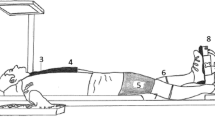Summary
Eight healthy male subjects (age range 24–38 year) were asked to exert a fatiguing isometric endurance contraction with their handgrip muscles at 40% of their maximum strength after immersion of their forearms in water at various temperatures ranging from 3–40‡ C. For each subject, isometric endurance was longest after immersion of his forearm in water at a particular characteristic bath temperature; endurance decreased markedly above or below this temperature. The increase in heart rate from the beginning to the end of the fatiguing contractions was the same irrespective of the bath temperature. In contrast, the increase in blood pressure (both systolic and diastolic) throughout the contractions was almost constant for contractions exerted after immersion of the forearm in water at 20–40‡ C, but was reduced progressively for contractions exerted in water below 20‡ C.
Similar content being viewed by others
References
Alarm M, Smirk H (1938) Observations on the pulse accelerating reflex from the voluntary muscles of the legs. J Physiol (Lond) 92: 167–177
Assmussen E, Hansen E (1938) über den Einflu\ statischer Muskelarbeit auf Atmung und Kreislauf. Scand Arch Physiol 78: 283–291
Clarke RS, Hellon RF, Lind AR (1958) Duration of sustained contractions of the human forearm at different muscle temperatures. J Physiol (Lond) 143: 454–462
Coote JJ, Hilton SM, Perez-Gonzalez JF (1971) The reflex nature of the pressor response to muscular exercise. J Physiol (Lond) 215: 789–804
Cullingham P, Lind AR, Morton R (1960) The maximal isometric tetanic tensions developed in mammalian muscle in situ at different muscle temperatures. Q J Exp Physiol 45: 142–155
Freyschuss U (1970) Elicitation of the heart rate and blood pressure increase on muscle contraction. J Appl Physiol 28: 758–761
Funderburk CC, Hipskind SG, Welton RF, Lind AR (1974) The development of and recovery from muscular fatigue induced by static effort at different tensions. J Appl Physiol 37: 392–396
Hall VE, Mendoz E, Fitch B (1947) Reduction of the strength of muscle contraction by the application of moist heat to the overlying skin. Arch Phys Med Rehabil 28: 493–499
Hnik PO, Kucera J, Payne R (1969) Actuation of muscle afferents by nonproprioceptive stimuli. Am J Physiol 217: 1451–1460
Humphreys PW, Lind AR (1963) The blood flow through active and inactive muscles of the forearm during sustained handgrip contractions. J Physiol (Lond) 166: 120–135
Keys A, Brozek J (1953) Body fat in adult men. Physiol Rev 33: 245–325
Simonson E, Lind AR (1971) Fatigue in static work. In: Simonson E (ed) Physiology of work capacity and fatigue. Thomas, Springfield, IL, pp 241–284
Lind AR, Taylor SJ, Humphreys PW, Kenelly BM, Donald KW (1964) Circulatory effects of sustained voluntary muscle contration. Clin Sci Mol Med 27: 229–244
McClosky DI, Mitchell JH (1972) Reflex cardiovascular and respiratory responses originating in exercising muscle. J Physiol (Lond) 224: 173–187
Petrofsky JS, Lind AR (1975a) The relationship of body fat content to deep muscle temperature and isometric endurance in man. Clin Sci Mol Med 48: 405–412
Petrofsky JS, Lind AR (1975b) The insulative power of body fat on deep muscle temperature and isometric endurance. J Appl Physiol 39: 639–642
Petrofsky JS, Lind AR (1975c) Aging, isometric strength and endurance and cardiovascular responses to static effort. J Appl Physiol 38: 91–95
Petrofsky JS, Lind AR (1980) The influence of temperature on the isometric characteristics of fast and slow muscle in the cat. Eur J Physiol (in press)
Petrofsky JS, Burse RL, Lind AR (1975) Comparison of physiological responses of women and men to isometric exercise. J Appl Physiol 38: 863–868
Petrofsky JS, LeDonne DM, Rinehart JS, Lind AR (1976) Isometric strength and endurance during the menstrual cycle. Eur J Appl Physiol 35: 1–10
Vernon HM (1924) The influence of rest powers and changes of posture on the capacity for muscular work. Rep Indust Fatig Res Bd (Lond) 29: Part B
Author information
Authors and Affiliations
Additional information
Supported by Air Force grant number AFOSR-76-3084 and by the Aerospace Medical Research Lab, Dayton, Ohio under Air Force Contract F 33615-78-C-0501
Rights and permissions
About this article
Cite this article
Petrofsky, J.S., Burse, R.L. & Lind, A.R. The effect of deep muscle temperature on the cardiovascular responses of man to static effort. Europ. J. Appl. Physiol. 47, 7–16 (1981). https://doi.org/10.1007/BF00422478
Accepted:
Issue Date:
DOI: https://doi.org/10.1007/BF00422478




